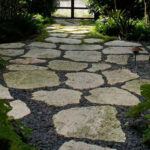Flagstone pavers are a popular choice for outdoor flooring, whether you’re looking to create a welcoming patio, a charming walkway, or a stunning pool deck. Their natural beauty, durability, and versatility make them a top choice for homeowners and landscapers alike. If you’re considering installing flagstone pavers in your outdoor space, this ultimate guide has everything you need to know to make an informed decision.
What is Flagstone?
Flagstone is a natural sedimentary rock that is split into layers to create flat, thin stones. These stones are typically used for paving and are available in a variety of colors, textures, and sizes. Flagstone is a popular choice for outdoor flooring because of its natural beauty and durability.
Types of Flagstone
There are several types of flagstone available, each with its own unique characteristics. The most common types of flagstone used for pavers include:
– Bluestone: A popular choice for its blue-gray hues and durability – Sandstone: Known for its warm, earthy tones and natural texture – Slate: Offers a sleek, modern look with a range of colors – Limestone: Features a softer, more muted color palette
Choosing the right type of flagstone for your project will depend on your design preferences, budget, and the amount of foot traffic the area will receive.
Benefits of Flagstone Pavers
Flagstone pavers offer a wide range of benefits that make them a popular choice for outdoor flooring projects. Some of the key benefits include:
– Durability: Flagstone is a natural stone that is resistant to weathering, erosion, and heavy foot traffic. – Natural Beauty: The unique colors, textures, and patterns of flagstone add a touch of natural beauty to any outdoor space. – Versatility: Flagstone pavers can be used in a variety of applications, from patios and walkways to pool decks and garden paths. – Low Maintenance: Flagstone is easy to clean and requires minimal maintenance to keep it looking its best.
Installation Tips
Installing flagstone pavers is a relatively straightforward process, but it does require some planning and preparation. Here are some tips to help you get started:
– Plan Ahead: Before you start laying the pavers, make sure to plan out your design and gather all the necessary materials. – Prepare the Base: Properly prepare the base by clearing the area of debris, adding a layer of compacted gravel, and ensuring that the surface is level. – Lay the Pavers: Start by laying the pavers in a pattern that fits your design, leaving small gaps between each stone. – Fill the Gaps: Once the pavers are in place, fill the gaps between the stones with sand or gravel to secure them in place. – Seal the Surface: To protect the pavers and enhance their natural beauty, consider applying a sealant after installation.
Maintenance Tips
To keep your flagstone pavers looking their best for years to come, follow these maintenance tips:
– Regular Cleaning: Sweep or wash the pavers regularly to remove dirt, debris, and stains. – Sealant: Reapply a sealant every few years to protect the pavers from moisture, stains, and UV damage. – Repair Cracks: If you notice any cracks or loose stones, repair them promptly to prevent further damage. – Weed Prevention: Keep the gaps between the pavers filled with sand or gravel to prevent weeds from growing.
In conclusion, flagstone pavers are a beautiful and durable choice for outdoor flooring projects. By choosing the right type of flagstone, properly installing the pavers, and following a regular maintenance routine, you can enjoy the natural beauty of flagstone in your outdoor space for years to come. So, whether you’re looking to create a stylish patio, a welcoming walkway, or a stunning pool deck, flagstone pavers are sure to impress.




















